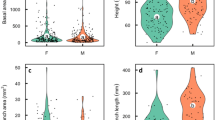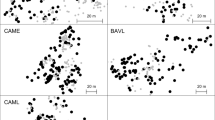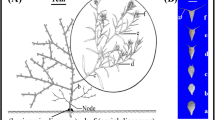Abstract
Studies on the population biology of dioecious plants have concentrated on deviations from the expected sex ratio of 1:1 (refs 1–4) and on sexual imorphism5–10. Sexual dimorphism may imply that the two sexes have different ecologies and this has been demonstrated for a number of animals11. Clearly, if males and females occupy at least partially different niches, competition between members of the two sexes will be reduced and observed sex ratios may be biased by the relative carrying capacities of the two niches. Putwain and Harper12 described differences in the seasonal patterns of growth of males and females in Rumex acetosa and Rumex acetosella and Freeman et al. 13 showed that the males of five dioecious plant species in northern Utah were more abundant on xeric microsites, while females were over-represented in the moister regions of each local environment. We report here that the growth of male and female plants of the annual Spinacia oleracea L. var. Viking is affected differently by population density, and this is reflected in the sex ratio.
This is a preview of subscription content, access via your institution
Access options
Subscribe to this journal
Receive 51 print issues and online access
$199.00 per year
only $3.90 per issue
Buy this article
- Purchase on Springer Link
- Instant access to full article PDF
Prices may be subject to local taxes which are calculated during checkout
Similar content being viewed by others
References
Schaffner, J. H., Am. J. Bot. 9, 72–78 (1972).
Malhotra, R. C. J. Genet. 23, 157–172 (1930).
Godley, E. J. N.Z.J. Bot. 2, 205–212 (1964).
Godley, E. J. N.Z.J. Bot. 14, 299–306 (1976).
Tiedjens, V. A. Proc. Am. Soc. hort. Sci. 21, 129–140 (1924).
Rosa, J. T. Hilgardia 1, 259–274 (1925).
Robbins, W. W. & Jones, H. A. Proc. Am. Soc. hort. Sci. 23, 19–23; 23–25 (1926).
Haber, E. S. J. agric. Res. 45, 101–109 (1932).
Rawes, A. N. J. R. hort. Soc. 60 452–453 (1935).
Thomson, C. L. & Robb, O. J. Sci. Agric., Ottawa 26 289–299 (1946).
Selander, R. K. Condor 68, 113–151 (1966).
Putwain, P. D. & Harper, J. L. J. Ecol., 60, 113–129 (1972).
Freeman, D. C., Klikoff, L. G. & Harper, K. T. Science 193, 597–599 (1976).
Zwaan, A. R. Seed World 18, 7–9 (1925).
Rosa, J. T. Experimental Evolution 108 (1892).
Author information
Authors and Affiliations
Rights and permissions
About this article
Cite this article
Onyekwelu, S., Harper, J. Sex ratio and niche differentiation in spinach (Spinacia oleracea L.). Nature 282, 609–611 (1979). https://doi.org/10.1038/282609a0
Received:
Accepted:
Issue Date:
DOI: https://doi.org/10.1038/282609a0
This article is cited by
-
Sexual dimorphism in response to herbivory and competition in the dioecious herb Spinacia oleracea
Plant Ecology (2019)
-
Sex-specific competition differently regulates ecophysiological responses and phytoremediation of Populus cathayana under Pb stress
Plant and Soil (2017)
-
Sex ratios and population persistence in the rare shrub Lindera subcoriacea Wofford
Plant Ecology (2013)
-
The influence of hydrological regimes on sex ratios and spatial segregation of the sexes in two dioecious riparian shrub species in northern Sweden
Plant Ecology (2010)
-
Females make tough neighbors: sex-specific competitive effects in seedlings of a dioecious grass
Oecologia (2006)
Comments
By submitting a comment you agree to abide by our Terms and Community Guidelines. If you find something abusive or that does not comply with our terms or guidelines please flag it as inappropriate.



